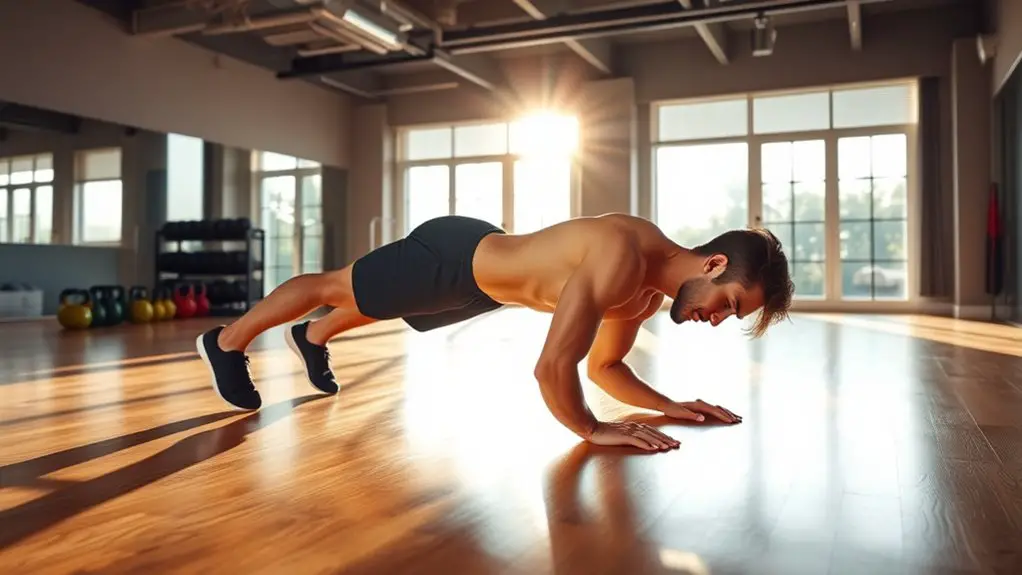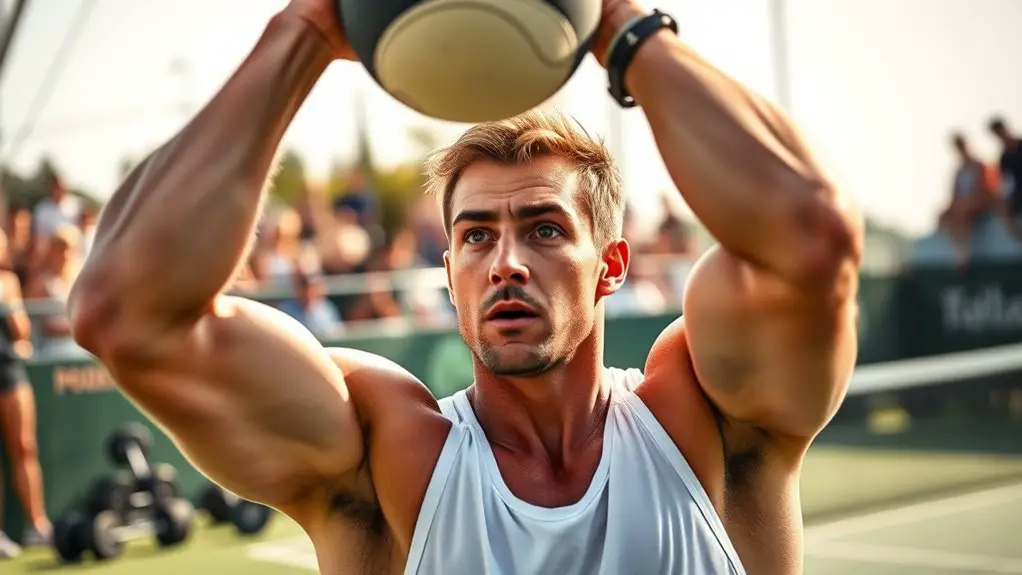To excel in paddle sports, you need a well-rounded strength training routine. Focus on core strength with planks and twists for stability, enhance upper body power through pull-ups and resistance bands, and build lower body endurance with squats and lunges. Also, incorporate flexibility and mobility routines to improve your range of motion. This balanced approach not only boosts your performance on the water but also helps prevent injuries. There's more to discover about optimizing your training.
Core Strength Exercises for Paddle Sports
When you're out on the water, having a strong core isn't just beneficial; it's essential for effective paddling. A solid core helps you maintain balance and stability, giving you the freedom to navigate effortlessly. To build this strength, focus on balance drills and stability exercises that engage your entire midsection.
Try incorporating exercises like planks or Russian twists into your routine. These moves not only enhance core strength but also improve your overall paddling technique. You can also practice balance drills on a paddleboard or kayak, challenging yourself to maintain your stability while shifting your weight. A well-conditioned core helps prevent injuries and allows you to enjoy unrestricted physical pursuits while paddling.
Upper Body Workouts to Enhance Paddling Power
A strong core lays the groundwork for powerful paddling, but upper body strength is just as essential for maximizing your performance on the water. To get that extra edge, focus on pull up variations, which engage your back, shoulders, and arms—crucial muscles for effective paddling. You can mix it up with wide grip, chin-ups, or even assisted pull-ups if you're building up your strength.
Incorporating resistance band exercises into your routine can also boost your paddling power. Try seated rows or band pull-aparts to enhance shoulder stability and improve your stroke technique. These exercises not only build strength but also keep your muscles flexible, allowing for a free range of motion while paddling. Additionally, developing grip strength through exercises like Farmers Walk can further enhance your paddling performance by improving stability and coordination.
Lower Body Strength Training for Stability and Endurance
While upper body strength is essential for paddling, lower body strength training is equally important for maintaining stability and endurance on the water. Strengthening your legs can ultimately enhance your performance and freedom while paddling. Incorporate squat variations and lunging techniques into your routine to build a solid foundation. Additionally, focusing on balance and stability will contribute to improved performance in paddling.
| Exercise Type | Description |
|---|---|
| Squat Variations | Try traditional squats, goblet squats, or single-leg squats to target your quads, hamstrings, and glutes. |
| Lunging Techniques | Implement forward, reverse, and lateral lunges to improve balance and coordination, vital for stability during paddling. |
| Combined Movements | Pair squats with lunges in a circuit to boost endurance and mimic paddling movements. |
Flexibility and Mobility Routines for Optimal Performance
To guarantee ideal performance in paddle sports, incorporating flexibility and mobility routines is essential. You'll want to enhance your range of motion and prevent injuries, allowing you to paddle with freedom and confidence. Start your workouts with dynamic stretching, focusing on movements that mimic paddling motions. This'll warm up your muscles and increase blood flow, preparing you for action.
Don't forget about foam rolling! It's a fantastic tool for releasing muscle tension and improving mobility. Spend a few minutes rolling out your back, legs, and shoulders, targeting any tight spots. This'll help you recover faster and feel more agile on the water. Additionally, regular mobility training can reduce injury risk, empowering you to explore new movements with confidence.
Sample Strength Training Regimen for Paddle Athletes
Strength training is essential for paddle athletes looking to enhance their performance and endurance on the water. Here's a sample strength training regimen that'll get you on the right track:
| Exercise | Sets | Reps |
|---|---|---|
| Squats | 3 | 12 |
| Bent-over Rows | 3 | 10 |
| Plank Variations | 3 | 30s |
| Medicine Ball Twists | 3 | 15 |
Incorporating these exercises into your routine will help build the strength and power needed for those long paddles. Focus on form, and don't rush through the reps. You want to feel the burn, but you also want to be free to paddle without injury. This regimen will not only improve your strength but also your overall confidence on the water. Embrace the journey and let your strength training elevate your paddle game! Remember, prioritizing core stability and strength is crucial for maximizing your performance on the water.
Frequently Asked Questions
How Often Should I Strength Train for Paddle Sports?
When it comes to strength training for paddle sports, frequency recommendations suggest you aim for at least two to three sessions a week. This allows you to build endurance and power without overdoing it. Creating a balanced training schedule is key—mix in rest days to recover. Listen to your body; if you feel fatigued, it's okay to adjust your routine. Ultimately, it's about finding a rhythm that gives you both strength and freedom on the water.
What Equipment Do I Need for Strength Workouts?
For your strength workouts, you don't need a gym full of equipment. Resistance bands are versatile and great for building strength without heavy weights. Free weights, like dumbbells or kettlebells, are also essential, as they allow you to target specific muscle groups effectively. With just these two types, you can create a variety of workouts that fit your style and give you the freedom to train anywhere. Enjoy your strength journey!
Can I Do Strength Training at Home?
Absolutely, you can turn your home into a personal gym without breaking the bank! Think of bodyweight exercises as your trusty companions; they're always there, ready to help you build strength. Add resistance bands to the mix, and you've got a versatile setup. With a little creativity, you can craft an effective workout routine that fits your lifestyle, giving you the freedom to train whenever and wherever you want.
How Long Should Each Workout Session Last?
When you're planning your workout duration, aim for 30 to 60 minutes per session. It really depends on your session intensity; higher intensity workouts might be shorter, while lower intensity ones can last longer. Listen to your body, and adjust as needed. You've got the freedom to experiment, so find what feels right for you. Consistency is key, but don't forget to enjoy the process and have fun with your training!
Should I Focus on Strength or Endurance Training More?
When considering strength vs. endurance, it's essential to find a training balance that suits your goals. If you're looking for overall performance, don't neglect either aspect. Strength training builds power and stability, while endurance work enhances stamina for longer activities. You might want to alternate between both types in your routine, allowing your body to adapt and thrive. Ultimately, it's about feeling free and capable in whatever you choose to pursue!




